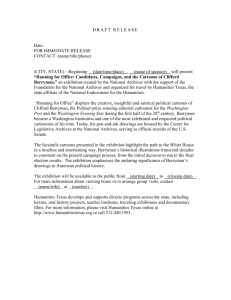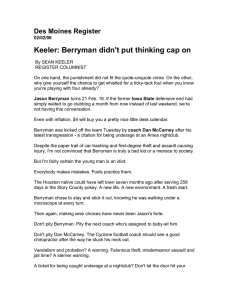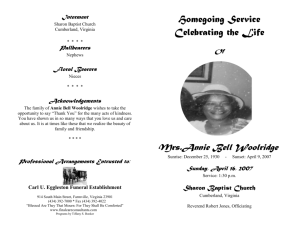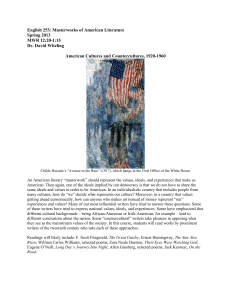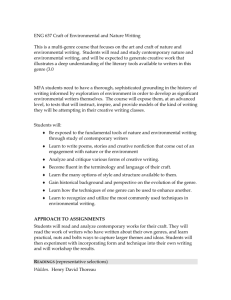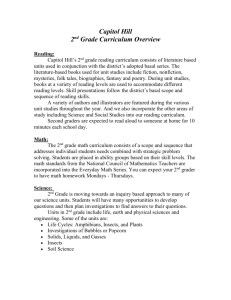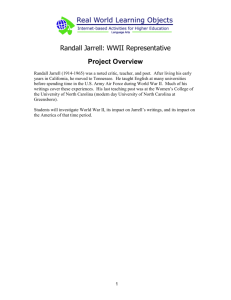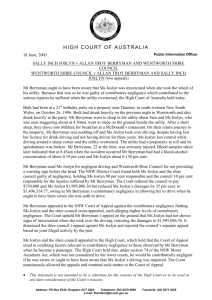PDF - Wilson Quarterly
advertisement
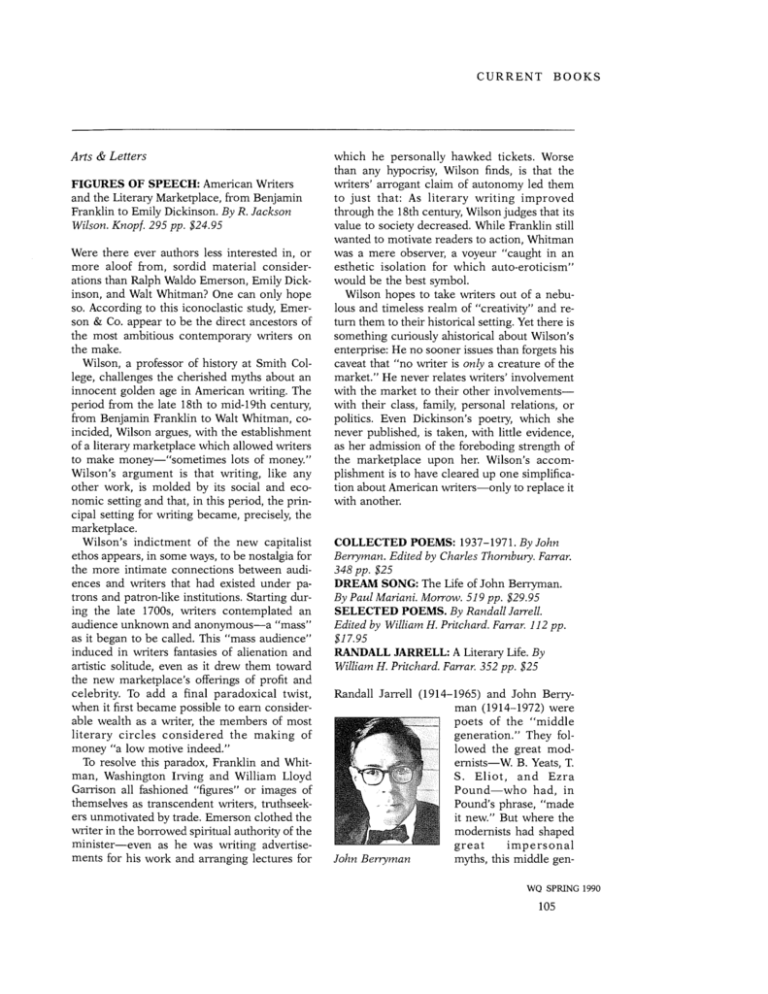
CURRENT BOOKS Arts & Letters FIGURES OF SPEECH: American Writers and the Literary Marketplace, from Benjamin Franklin to Emily Dickinson. By R. Jackson Wilson. Knopf. 295 pp. $24.95 Were there ever authors less interested in. or more aloof from, sordid material considerations than Ralph Waldo Emerson, Emily Dickinson, and Walt Whitman? One can only hope so. According to this iconoclastic study, Emerson & Co. appear to be the direct ancestors of the most ambitious contemporary writers on the make. Wilson, a professor of history at Smith College, challenges the cherished myths about an innocent golden age in American writing. The period from the late 18th to mid-19th century, from Benjamin Franklin to Walt Whitman, coincided, Wilson argues, with the establishment of a literary marketplace which allowed writers to make money-"sometimes lots of money." Wilson's argument is that writing, like any other work. is molded bv its social and economic setting and that, in this period, the principal setting for writing became, precisely, the marketplace. Wilson's indictment of the new capitalist ethos appears, in some ways, to be nostalgia for the more intimate connections between audiences and writers that had existed under patrons and patron-like institutions. Starting during the late 1700s, writers contemplated an audience unknown and anonymous-a "mass" as it began to be called. This "mass audience" induced in writers fantasies of alienation and artistic solitude. even as it drew them toward the new marketplace's offerings of profit and celebrity. To add a final paradoxical twist, when it first became possible to earn considerable wealth as a writer, the members of most literary circles considered the making of money "a low motive indeed." To resolve this paradox, Franklin and Whitman, Washington Irving and William Lloyd Garrison all fashioned "figures" or images of themselves as transcendent writers, truthseekers unmotivated by trade. Emerson clothed the writer in the borrowed spiritual authority of the minister-even as he was writing advertisements for his work and arranging lectures for which he personally hawked tickets. Worse than any hypocrisy, Wilson finds, is that the writers' arrogant claim of autonomy led them to just that: As literary writing improved through the 18th century, Wilson judges that its value to society decreased. While Franklin still wanted to motivate readers to action, Whitman was a mere observer, a voyeur "caught in an esthetic isolation for which auto-eroticism" would be the best symbol. Wilson hopes to take writers out of a nebulous and timeless realm of "creativity" and return them to their historical setting. Yet there is something curiously ahistorical about Wilson's enterprise: He no sooner issues than forgets his caveat that "no writer is only a creature of the market." He never relates writers' involvement with the market to their other involvementswith their class, family, personal relations, or politics. Even Dickinson's poetry, which she never published, is taken, with little evidence, as her admission of the foreboding strength of the marketplace upon her. Wilson's accomplishment is to have cleared up one simplification about American writers-only to replace it with another. COLLECTED POEMS: 1937-1971. By John Bertyman. Edited by Charles Thornbury. Farrar. 348 pp. $25 DREAM SONG: The Life of John Berryman. By Paul Mariani. Morrow. 519 pp. $29.95 SELECTED POEMS. By Randall Jarrell. Edited by William H. Pritchard. Farrar. 112 pp. $17.95 RANDALL JARRELL: A Literary Life. By William H.Pritchard. Farrar. 352 pp. $25 Randall Jarrell (1914-1965) and John Berryman (1914-1972) were poets of the "middle generation." They followed the great modernists-W. B. Yeats, T. S. Eliot, a n d Ezra Pound-who had, in Pound's phrase, "made it new." But where the modernists had shaped great impersonal myths, this middle genJohn Berryman WQ SPRING 1990 CURRENT BOOKS eration forged painfully personal ones. Berryman was a confess-onal poet, and Jarrell wrote searingly about his experiences during the Second World War. Because they were their own subjects, says Pritchard, a professor of English at Amherst, "we care more about the life when we begin to care about the writing." These two sympathetic biographies-Jarrell's by Pritchard and Berryman's by Mariani-reveal the haunting similarities between the two poets' lives. Both men belonged to the first generation of poets as academics: Their home was neither the occult world of Yeats nor the rural life of Frost but the classroom, the critical journal, and the poetry seminar. Of Berryman, Mariani observes that "except for the intense industry, the lifelong obsession. . . of getting words down on the page and getting them absolutely right, there is nothing out of the ordinary about what Berryman did." Successful as a poet, Berryman seemed inept at anything else: He could barely cook a meal or make sense of his bank statement. Berryman's suicide may have an air of inevitability about it, considering his alcoholism and depression. But what about Jarrell? Neither an alcoholic nor a manic-depressive, he also apparently took his own life. Both were typical of the middle-generation poets-one thinks of Robert Lowell, Theodore Roethke, Delmore Schwartz-who came to sad ends. Yet, in his poetry, Berryman's life could become witty and even comic. Take his "Dream Song # 14," which begins, "Life, friends, is boring. We must not say so," and concludes with a conceit worthy of a midwestern John Donne: and somehow a dog has taken itself & its tail considerably away into mountains or sea or sky, leaving behind: me, wag. Berryman's Collected Poems omits his masterpiece, The Dream Songs (too bulky to include). But the Collected Poems effectively traces Berryman's growth, from his early (unsuccessful) imitation of Yeats and W. H. Auden through the finding of his own style in Homage to Mistress Bradstreet. That it's not his Collected but only his Selected Poems (a mere 50 in all) being reissued WQ SPRING 1990 indicates Jarrell's fallen reputation as a poet. Although a few poems"The Death of the Ball Turret Gunner," "The Woman at the Washington Zoo"-continue to be anthologized, Jarre11 is now known as the critic who helped Randall Jarrell shape his generation's taste in poetry. Jarrell wrote to Elizabeth Bishop that "one expects most of a good poet's work to be quite bad." Jarrell's critical method was, with an unfailing eye, to delineate what was good-the best poems and best lines. In this way, he revived Whitman's reputation and solidified Frost's, Stevens's, and Marianne Moore's. Why, upon this middle generation, did the practice of poetry take such a toll? These two biographies suggest an answer: Unlike their predecessors, Jarrell and Berryman did away with larger myths and had only themselves to fall back upon in their poetry; at various universities, they were free to be full-time poets. But such freedom may have been a burden in disguise. Berryman and Jarrell, having erased the modernist boundary between the poet and his work, saw no gap between "art" and "life" where they might have found respite from the ravages of each. ISARA: A Voyage Around "Essay." By Wole Soyinka. Random. 262 pp. $18.95 HOPES AND IMPEDIMENTS. By Chinua Achebe. Doubleday. 186 pp. $17.95 isarii is a "prequel" to Noble Prize winner Wole Soyinka's childhood memoir, Ak2 (1982). It is as if the Nigerian playwright, having examined the opposing forces of tradition and modernity that shaped his own experience, came to realize that the only way to fully understand himself was to know his father's world. i s a r ~an , inland Nigerian village, is the birthplace of Soyinka's father, Essay, a place to which Essay keeps returning despite his repeated attempts to leave it for good. What emerges from this chronicle are portraits from a not-too-distant past-the years before the Sec-
